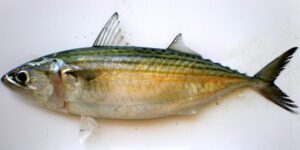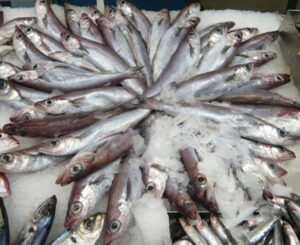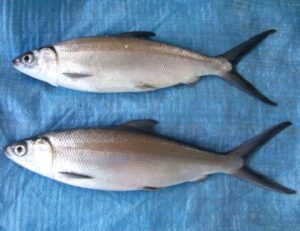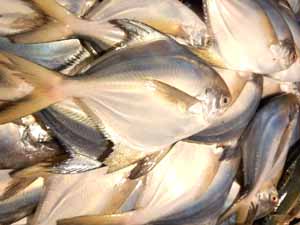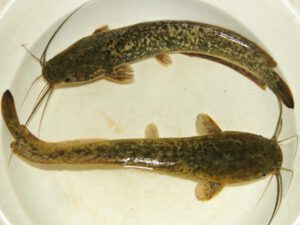The Lampuka is a beautiful and colorful fish species found in warm oceans. It is a very popular fish in many countries, cultures, and cuisines throughout the world. Lampuka fish is mainly popular and favorite among the fishermen and seafood lovers, mainly because of its color and interesting habits. These fish are popular in cooking because of their tasty and firm flesh. And they are often used in dishes like fish tacos and ceviche.
Body of Lampuka fish is often a mix of green, blue, and yellow colors, and their body coloration changes as the fish grow or get excited. The body is long and slender, with a slightly flattened shape. The fins are also colorful and can help the fish swim very fast.
The Lampuka fish generally live in warm ocean waters, and they are generally found in the tropical and subtropical regions of Atlantic and Pacific Oceans. They are available in the Caribbean Sea, the Gulf of Mexico, and the waters off the coast of Hawaii. They generally likes to stay near floating objects in the ocean. And these flying objects can be anything from seaweed to floating pieces of wood. Such objects attract small fish and other creatures that the Lampuka fish likes to eat. Sometimes, they are also found near the surface of the water where they hunt for food.
What is Lampuka fish?
The Lampuka is a brightly colored fish found in warm oceans around the world. It has a long, sleek body with vibrant blue, green, and yellow colors. It is also called “Mahi Mahi” and the scientific name is Coryphaena hippurus.

Lampuka fish in English?
The Lampuka fish is commonly known as “Mahi Mahi” in English.
Characteristics
The Lampuka fish are easily distinguished by their distinctive physical characteristics. They typically have bright, and striking colors, and have a mix of iridescent blue, green and yellow colors. Their body coloration can change rapidly, especially when the fish is excited or stressed. Their body is elongated and streamlined, and somewhat flattened on the sides.
They have long, continuous dorsal fin that extends from the head to the tail. The fins are tall and sail-like. The pectoral fins are long and pointed, and the pelvic fins are located on the underside of the body and are relatively small. The anal fin is long and runs parallel to the dorsal fin along the underside of the fish. Their tail is forked. The skin of the Lampuka fish is smooth and covered with small, fine scales. And the scales are relatively small and not very prominent.
Size and weight
The Lampuka fish can grow to about 90 to 120 cm in length and weigh between 15 to 30 pounds. Although, some fish can be larger in size and weigh more.
Diet
The diet of Lampuka fish mainly consists of smaller fish, squid, and crustaceans. They have sharp teeth and they use their teeth for catching their prey. They are known to be aggressive hunters. They often chase after their food with quick, sudden movements. They also like to feed near floating objects in the ocean, where small fish and other creatures gather.
Behavior
The Lampuka fish are known for their lively and energetic behavior. They can swim very fast and can make quick, sharp tuns for catching their prey. Their bright colors can change and become even more vivid, if they become excited or stressed. They often jump out of the water.
Reproduction
The reproduction process of the Lampuka fish occurs by laying eggs in the ocean. During their breeding season, they generally gather in groups, and the female fish release their eggs into the water. Then the male fish fertilizes the eggs. And after a few days, the eggs hatch into tiny baby fish called larvae. The larvae grow very fast and become mature within a few months, and the reproduction process starts again. The Lampukas have very high reproduction rate. And such high reproduction rate helps to maintain their populations in the wild.
Lifespan
Average lifespan of the Lampuka fish is between 4 to 5 years.
Uses
The Lampuka fish are well known and very popular mainly for their firm, white flesh and mild, slightly sweet taste. Besides being a delicious food, the Lampuka fish also important for sport fishing.

Cooking and recipes
There are several cooking ways and recipes available to try. But most common and popular ways for enjoying Lampuka fish are grilling, baking, pan-searing, broiling, and making Lampuka ceviche.
Nutrition
The Lampuka fish are highly nutritious and healthy food. A 100 gram serving provides:
Calories: Approximately 134 kcal
Protein: About 23 grams
Fat: Around 2.6 grams
Saturated Fat: 0.6 grams
Monounsaturated Fat: 0.8 grams
Polyunsaturated Fat: 0.6 grams (includes omega-3 fatty acids)
Cholesterol: About 70 milligrams
Carbohydrates: 0 grams
Fiber: 0 grams
Sodium: Approximately 60 milligrams
Potassium: Around 400 milligrams
Vitamin B12: Approximately 1.8 micrograms (30% of the daily value)
Vitamin D: About 0.5 micrograms (4% of the daily value)
Selenium: Approximately 36 micrograms (65% of the daily value)
Health Benefits
As you can see, the Lampuka fish are highly nutritious and provide several health benefits. Their high protein content supports good muscle growth and repair. It is a heart-healthy choice, as it is very low in fat (most of the fats are good fats). It is a good source of omega-3 fatty acids, which promotes cardiovascular health. It also a good source of vitamin B12 and selenium. Vitamin B12 is essential for energy and brain health, and selenium helps with antioxidant protection and immune function.
Taste
Taste of Lampuka fish is mild and slightly sweet. Its firm and flaky texture makes it ideal for various cooking ways.
Price
Its very tough for us to tell the exact price of Lampuka fish. Because exact price depends on numerous factors such as season, location, availability, freshness etc. But generally, you can expect the price ranging from $12 to $20 per pound of fresh fish. The frozen fish is less expensive and will cost you between $8 and $15 per pound.
Where to buy Lampuka fish?
You can buy Lampuka fish from many different options. Consider buying from your local seafood markets, supermarkets, specialty stores and online retailers.

